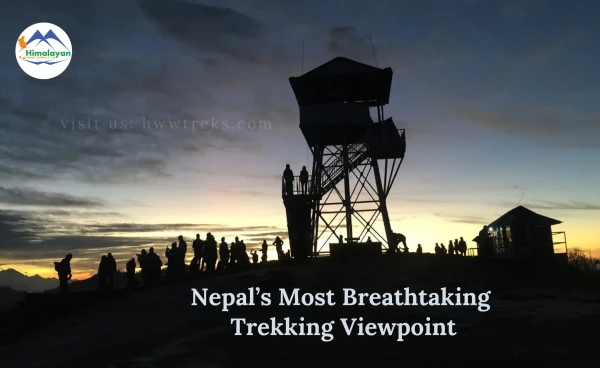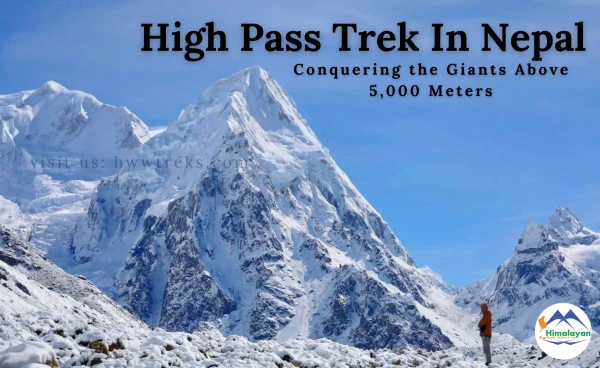- 09/17/2025
- Tags: Dolpo
- Yangchen Lhamo Gurung
Monasteries in the Dolpo Region: Hidden Spiritual Treasures of Nepal
In the remote northwestern corner of Nepal lies the Dolpo region, one of the last truly untouched places in the Himalayas. This region is not only a sacred treasure of Bon religion but also a haven for travellers and adventure seekers. Being surrounded by rich cultural heritages and the sacred Phoksundo Lake, the Dolpo region offers great solitude to visitors. Not only the natural landscape and culture and its tradition, but each monastery of this region has its unique identity, acting as a living museum that preserves its distinctive art, architecture, and sacred rituals. Visiting these monasteries offers a rare glimpse into Dolpo’s spiritual life, where one can immerse oneself in the traditional Buddhist architecture and rituals.
If you're drawn to more than just landscapes, if you seek wisdom, culture, and stories carved in stone and painted on walls, then Dolpo’s monasteries will leave a lasting impression on your soul. Here is a list of the monasteries that you should not miss during your visit to Dolpo
Contents [hide]
- Ringmo Bon Gonpa
- Shey Gonpa- The Heart of Upper Dolpo
- Namgung Monastery
- Samling Gonpa- Scared Lookout above Bhijer Village
- Monasteries of Saldang Village
- Yangtsher Gonpa - Hidden Jewel of Nisal Village
- Champa/ Jhampa Monastery
- Ribo Bhumpa Monastery- Cultural Center of Dho Tarap
- Sipchok Dedhen Phuntsokling Bon Monastery
- Concluison
Ringmo Bon Gonpa
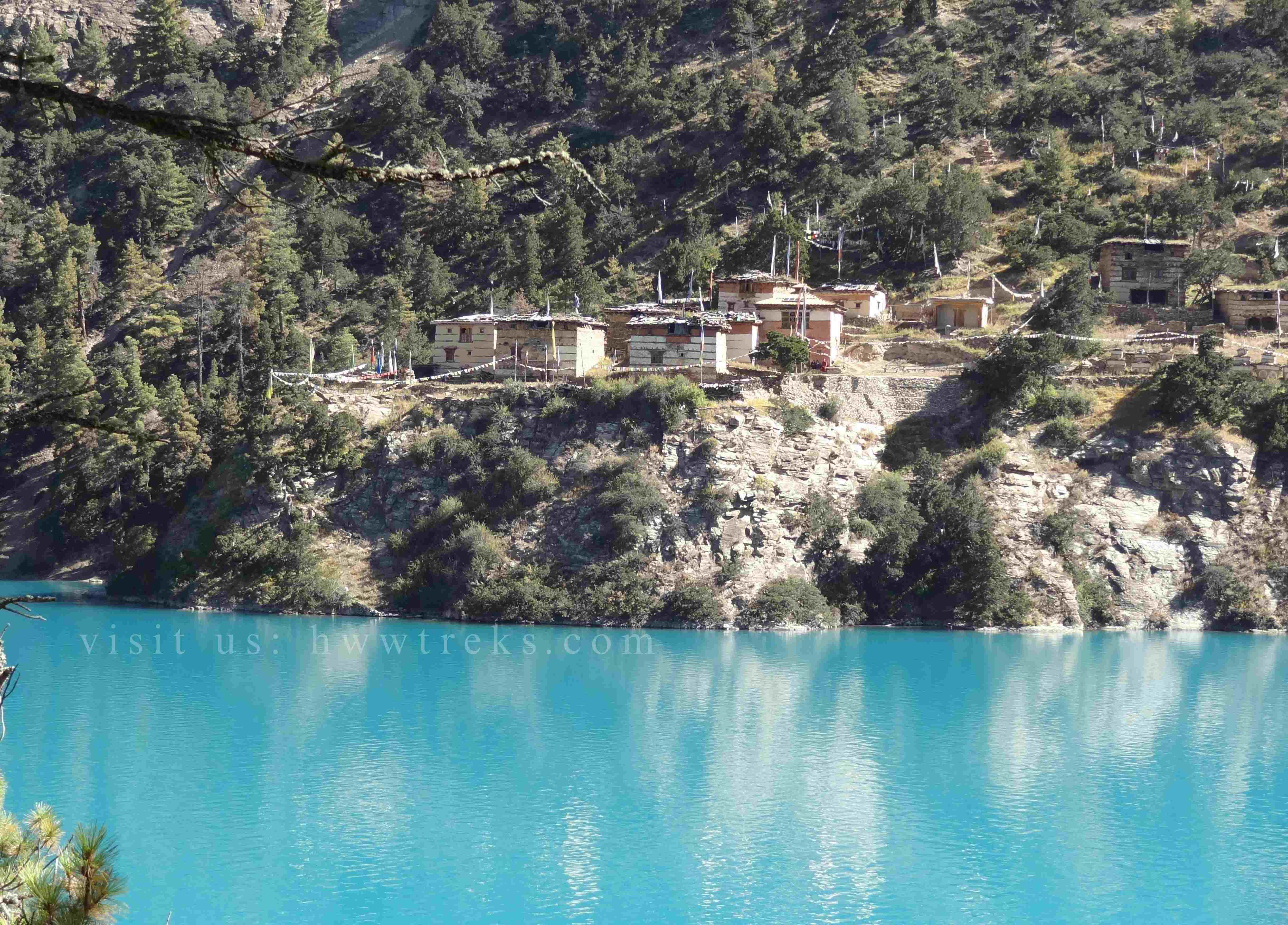
Ringmo Village, situated near the stunning Phoksundo Lake, is one of the liveliest settlements in Dolpo during trekking season. Although it consists of just around twenty traditional houses, the village feels warm and welcoming, especially with its unique Dolpo-style architecture, characterized by flat-roofed homes built from stacked stone and timber, most of which face east and have solid, windowless rear walls to shield against the wind.
Just above the village, on the northern shore of the lake, sits the serene Ringmo Bon Monastery, also known as Tshowa Bonpo Gonpa. The monastery is beautifully framed by rows of ochre and red-painted chortens and mani walls, creating a spiritual gateway to the sacred site. This ancient Bon monastery is believed to be over 800 years old, founded by a lama who came from the Pungmo Valley, located southwest of the lake.
To the west of the main temple is a smaller structure known as the Puja Gonpa, which has three levels and is currently home to Lama Sherab, under the spiritual leadership of Menri Triten Rinpoche, one of the highest authorities of the Bon tradition. While the inner halls are simple, they house small statues and a few thangka paintings that reflect the deep spiritual roots of the Bon religion.
Reaching the monastery is a peaceful 25-minute walk around the lake, through a pine forest, and across the Phoksundo Khola river, just past the local checkpoint.
Today, Ringmo Bon Monastery is not only a place of worship but also a living link to Dolpo’s ancient Bonpo heritage, offering visitors a rare chance to witness a spiritual tradition older than Buddhism itself, still practiced in its purest form amidst one of Nepal’s most breathtaking landscapes.
Shey Gonpa- The Heart of Upper Dolpo
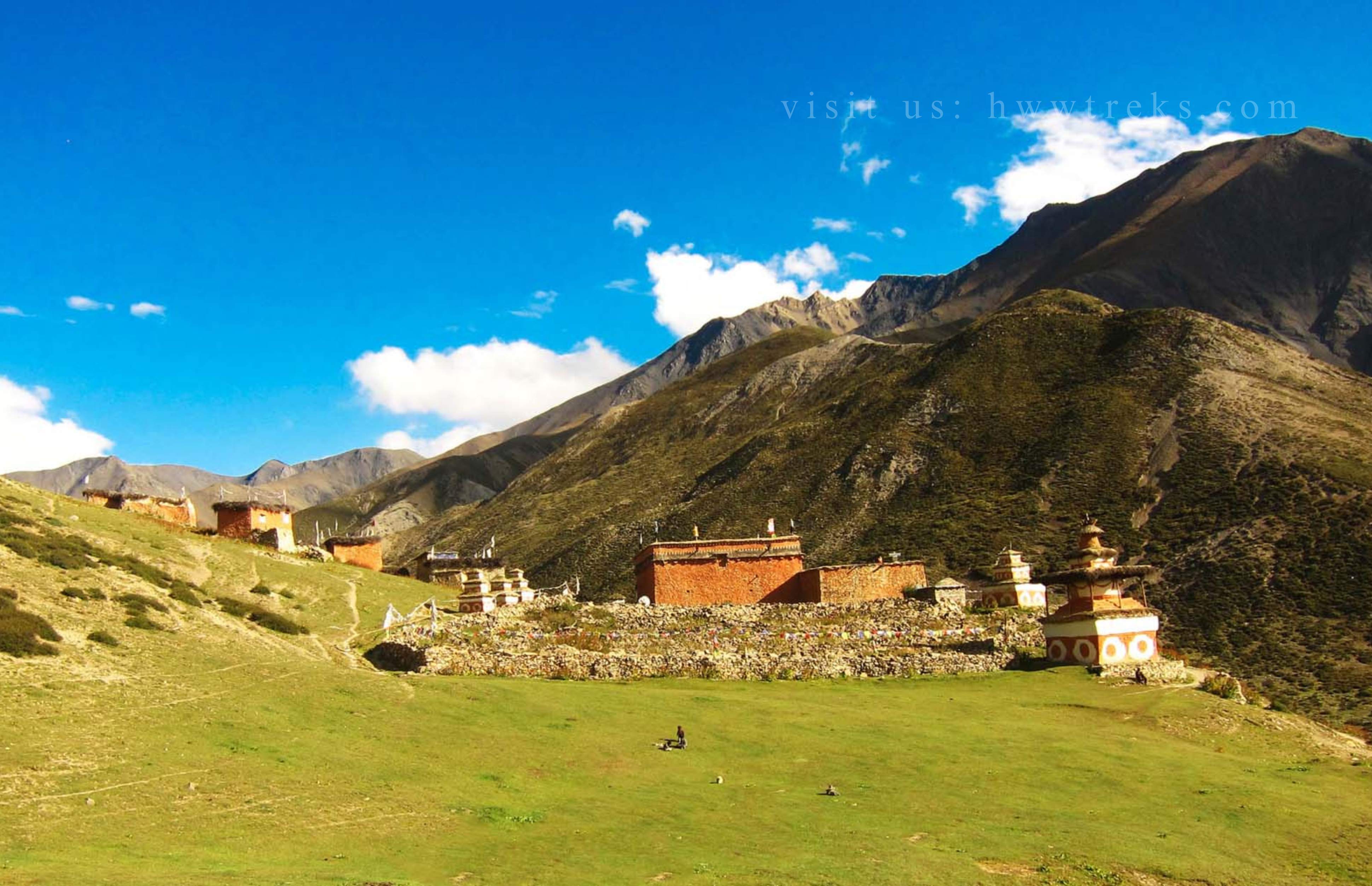
Shey Gonpa, built in the 11th century, is one of the most revered monasteries in Dolpo, perched near the sacred Crystal Mountain in Upper Dolpo. The word “Shey” means “crystal or glass,” and “Gonpa” means monastery in the Tibetan language. Locally, it is known as “Shelri Sumdho Gonpa.” Belonging to the Kagyu lineage of Tibetan Buddhism, this monastery is central to the spiritual life of the region, especially during the famous Shey Festival/Mela held every 12 years, aligning with the Dragon Year of the Tibetan Lunar Calendar. This festival is celebrated as a symbol of winning against a demon or evil spirit. This two-story monastery has stone walls and a red-painted facade reflecting classic Tibetan architecture, while inside, ancient murals of Buddhist deities and life stories of revered lamas adorn the walls.
Shey Gonpa has three main Gonpas, including
1. Shel Sundo Gonpa
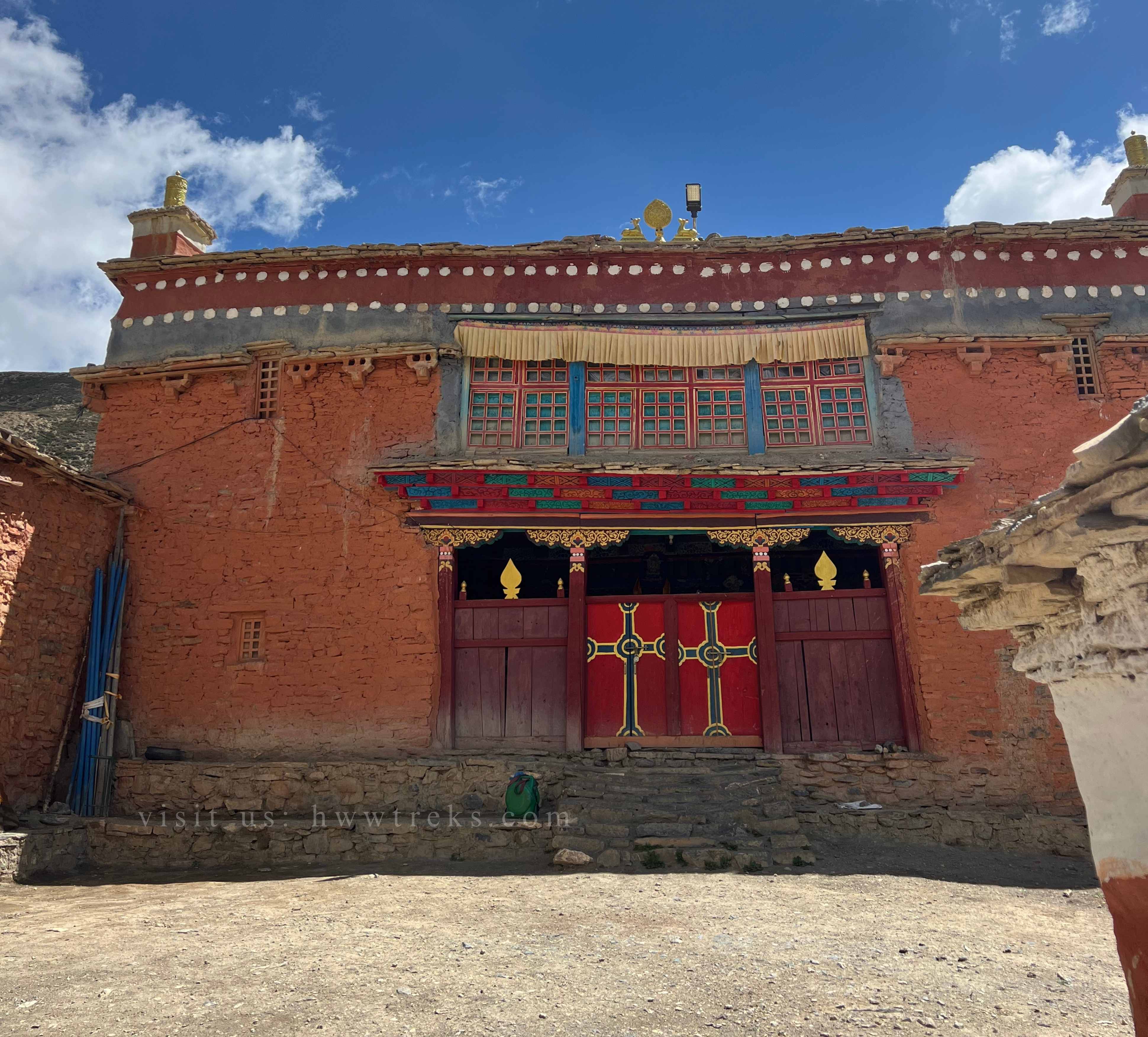 Located directly across from Crystal Mountain, Shel Sundo is a Kagyu-Nyingma monastery. Surrounded by many walls and chortens, this monastery radiates peaceful energy and ancient wisdom. Inside, you'll find sacred statues and thangka paintings of key Buddhist figures such as Dorje Chang, Shakyamuni Buddha, Green Tara, Milarepa, and Karmapa, as well as a rare depiction of the skeleton Buddha and the powerful Vajra Yogini.
Located directly across from Crystal Mountain, Shel Sundo is a Kagyu-Nyingma monastery. Surrounded by many walls and chortens, this monastery radiates peaceful energy and ancient wisdom. Inside, you'll find sacred statues and thangka paintings of key Buddhist figures such as Dorje Chang, Shakyamuni Buddha, Green Tara, Milarepa, and Karmapa, as well as a rare depiction of the skeleton Buddha and the powerful Vajra Yogini.
2. Komache Gonpa
At the edge of Shey village, nestled near the base of Crystal Mountain, lies Komache Gonpa, a Kagyupa temple established by the accomplished tantric master Druptop Singhe Yeshe. The monastery is home to a sacred stupa symbolizing ‘complete victory’ and preserves the footprint of Singhe Yeshe, offering a powerful blessing to those who visit.
3. Tsakang Gonpa
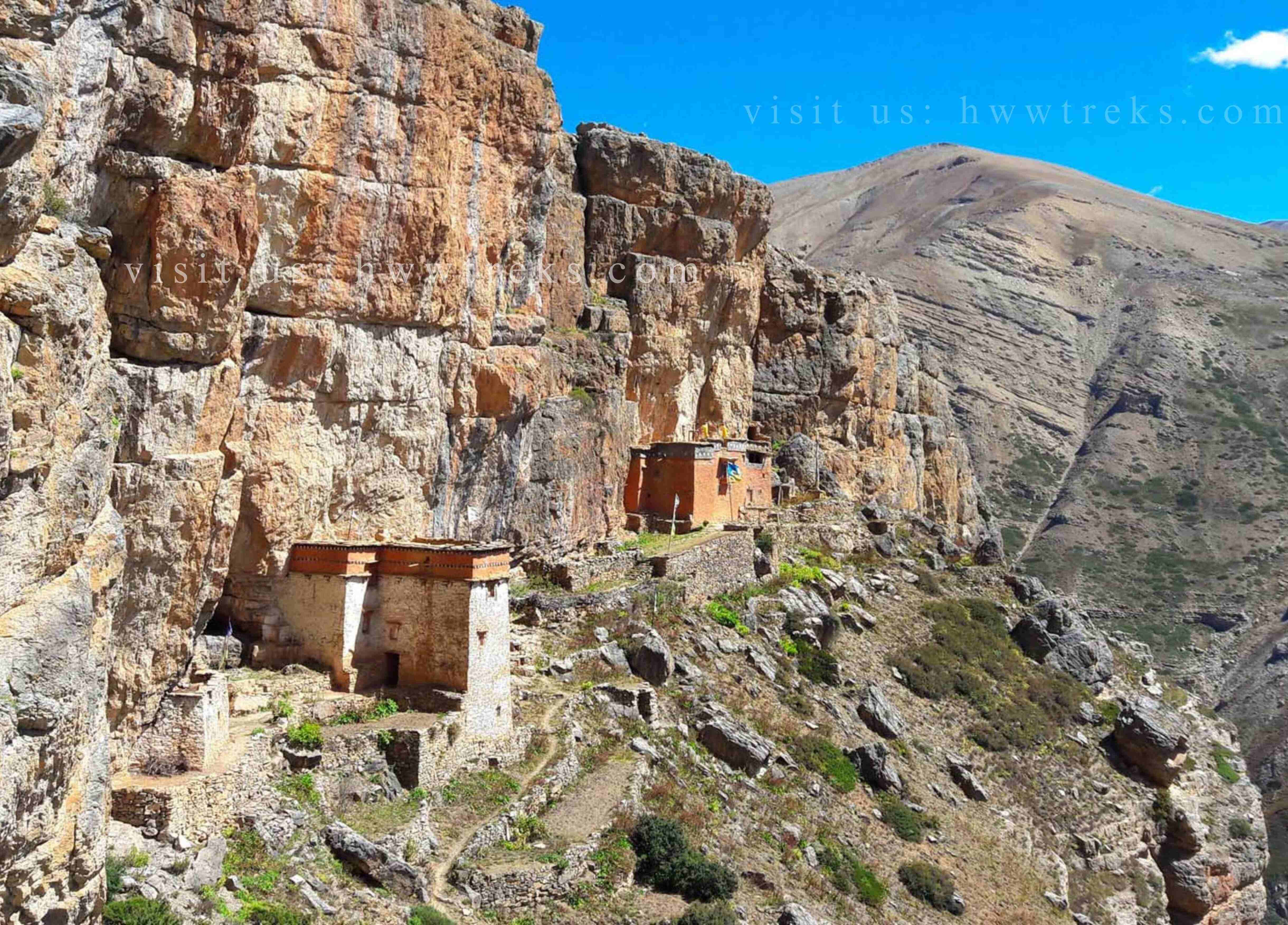 Perched dramatically on the red-brown cliffs near Shey, Tsakang Gonpa is known as a meditation retreat for the Lamas of Shey. Its remote location and striking setting above the village offer an ideal environment for deep spiritual practice and solitude.
Perched dramatically on the red-brown cliffs near Shey, Tsakang Gonpa is known as a meditation retreat for the Lamas of Shey. Its remote location and striking setting above the village offer an ideal environment for deep spiritual practice and solitude.
Reaching Shey Gonpa requires a special Upper Dolpo permit ($500 for 10 days), and the journey itself, deep within the protected Shey Phoksundo National Park, is as spiritually uplifting as the destination.
Namgung Monastery
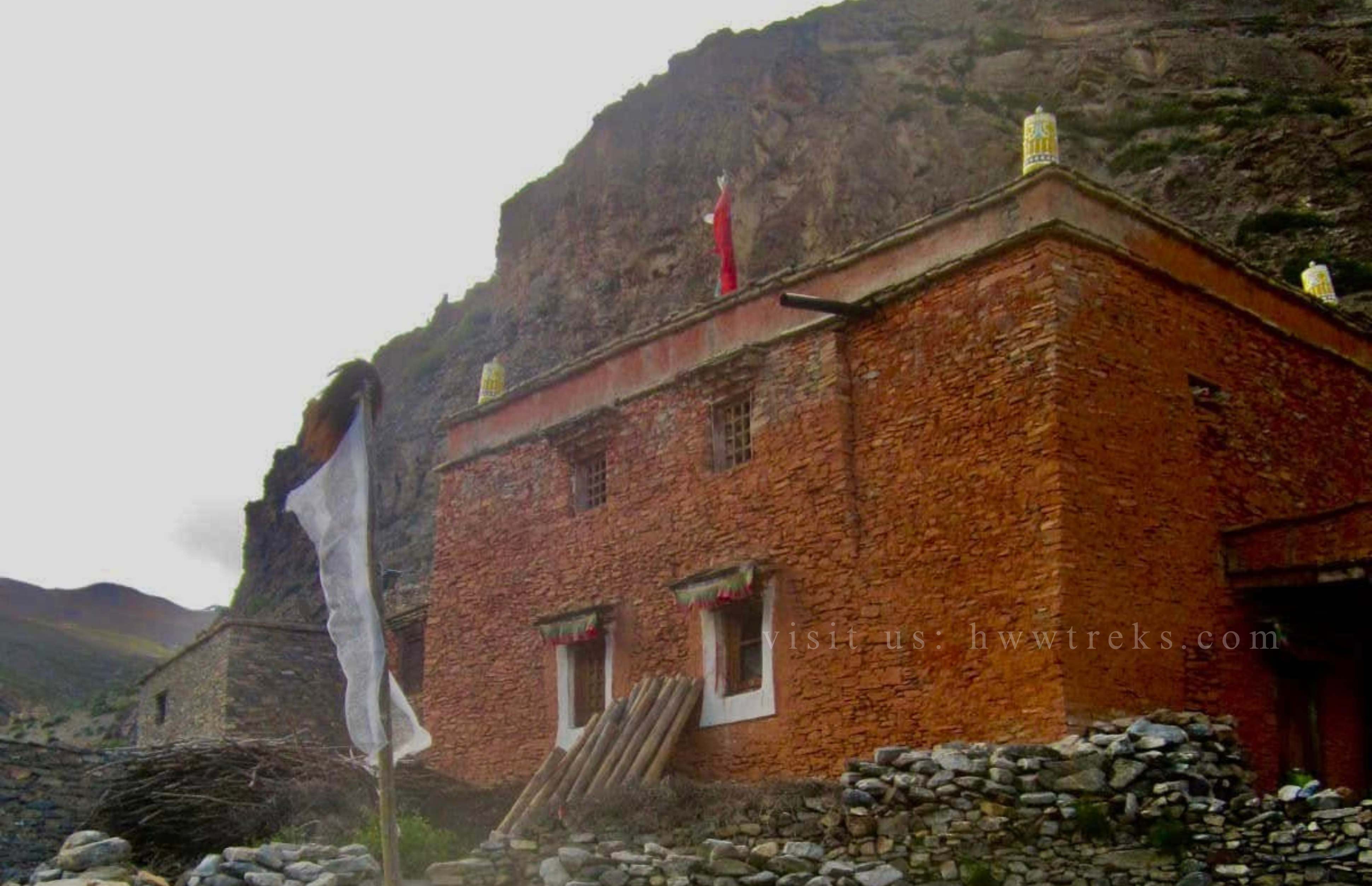
Tucked into the rugged hills of the Nangkhong Valley in Dolpo, Namgung Monastery (Pal Namgung Jangchub Ling Gonpa) is one of the oldest and most revered monasteries in the region. It holds deep cultural and spiritual significance as one of Dolpo’s three original “mother monasteries.” The Namgung Gonpa belongs to the Kagyu-pas sect, although, as with most monasteries across Dolpo, there is some mixing of icons. The Lhakang (“Lha” means “god” and “Kang” means “house or room”) hosted images of Sakyamuni, Guru Rinpoche, and a bronze Dorje Chang.
Historically, Namgung village was home to the Kowa community, the early tribal settlers who later established the kingdom of Saldang. The village and monastery are surrounded by rocky cliffs and natural caves, which for centuries served as meditative retreats for hermits and monks.
The spiritual roots of the monastery are traced to a meditation cave just beside the main temple, where the master Rachen Lophel Palsang is believed to have guided his disciples. In the 17th century, the respected teacher Drakkar Karma Lobsang laid the foundation of the monastery and built a retreat center, turning Namgung into a place of learning and practice.
Throughout its history, the monastery enjoyed the support of the kings of Jumla and Mustang, who endorsed its teachings and monastic codes. Spiritual leaders like Ngawang Namgyal, Jowo Ngawang Dhondup, and the Nyinchung lineage of lamas have carried on their legacy to this day.
Namgung Monastery remains a quiet sanctuary, where history, devotion, and tradition continue to thrive in the heart of the high Himalayas.
Samling Gonpa- Scared Lookout above Bhijer Village
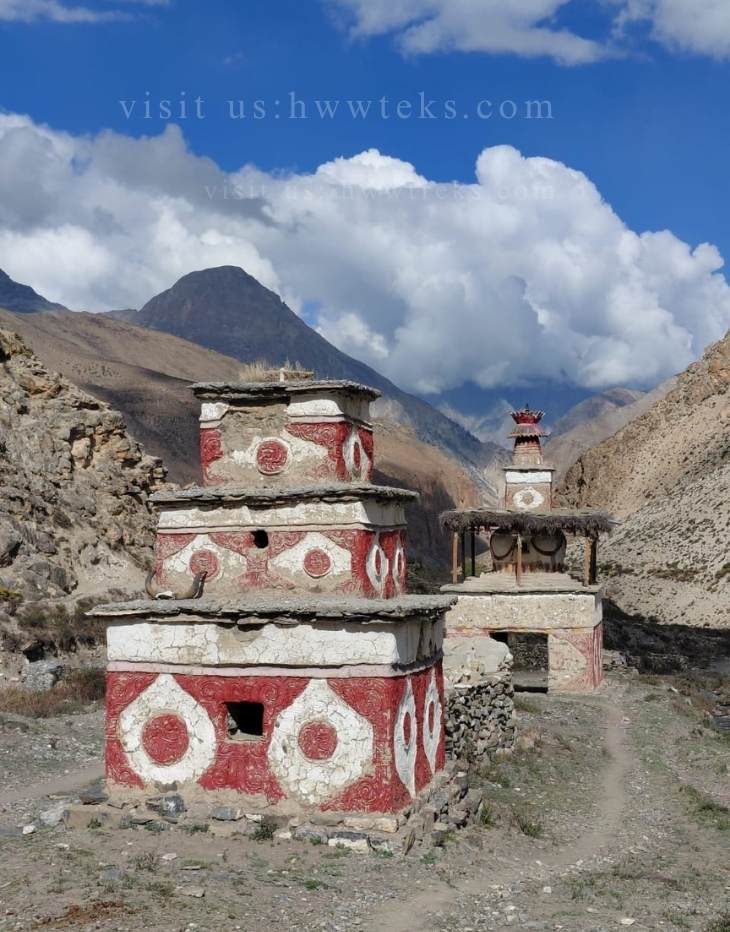
Located above the picturesque Bhijer Village in Upper Dolpo, Samling Gonpa is one of the most spiritually significant Bon institutions, dating back over 800 years, established by the revered Dzogchen master Tangton Gyaltzen Rinchen. From its early days, the monastery served as a vital center of learning and practice for the Bon tradition. Many Dzongchen lamas were taught here. Over the centuries, it became renowned for teachings in Sutra, Tantra, and Dzogchen (Great Perfection), drawing practitioners and scholars from across the region.
Affiliated with the Nyingma school, the monastery houses ancient thangkas, weathered murals, chortens, relics of several great tantras and Dzogchen practitioners, and a large statue of Guru Rinpoche (Padmasambhava). Outside the monastery, in the entrance area, there is a guardian figure and the four harmonious friends, animals stacked on each other, as seen in Buddhist Gonpas. A Mongolian tiger with a chain is an interesting painting similar to those of Guru Rinpoche found in Buddhist monasteries.
Its elevated position offers sweeping views of surrounding valleys and mountains, making the spiritual experience even more profound. The spiritual lineage continues under the guidance of Yangton Sherab Tenzin, the current Lama and custodian of this living Bon tradition. As it's situated in Upper Dolpo, visitors need a special permit, and the remote journey through Bhijer Valley ensures few crowds but unforgettable beauty.
Monasteries of Saldang Village
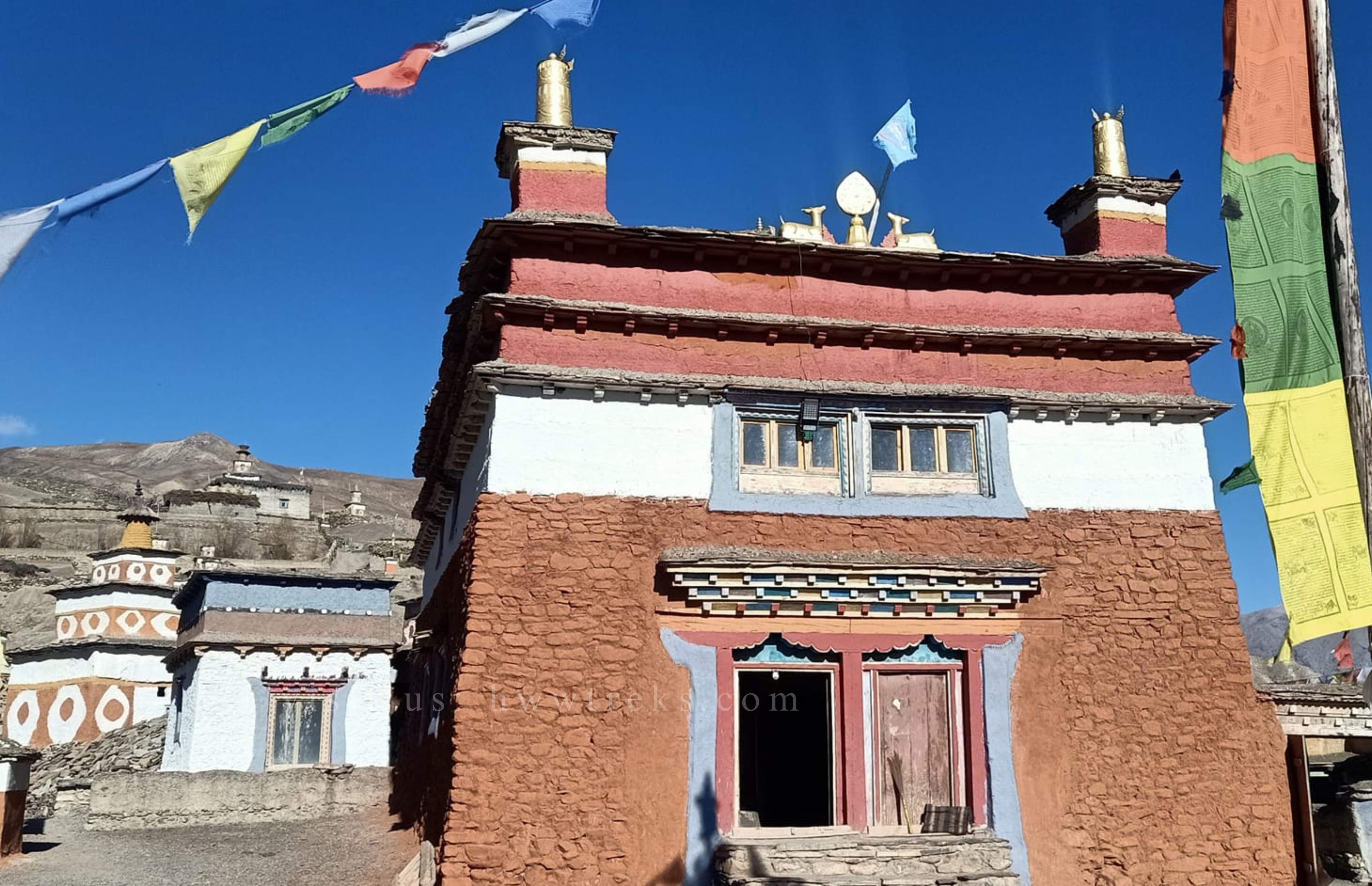
Located at an altitude of 3,770 meters, Saldang is one of the largest and most culturally rich villages in Upper Dolpo. Spread out along the mountainside just an hour’s walk beyond Nengla Pass, this traditional village is a window into life in one of Nepal’s most remote regions. Saldang gained some international attention when one of its locals, Amchi Labrang Tundup, was featured in the Oscar-nominated film Caravan/Himalaya.
What makes Saldang especially remarkable is its deep spiritual heritage. The village is home to several small monasteries, each tucked among homes or on quiet slopes, preserving centuries-old traditions of Tibetan Buddhism. Two of the most important among them include:
Samye Choling Monastery
Situated in the lower part of the village, Samye Choling belongs to the Nyingma school of Tibetan Buddhism. It was founded over 500 years ago under the guidance of Lama Sushing Urgyen Tenzin, although the site itself is believed to date back to the 12th century, with connections to Gyaltzen Rinchen.
Inside the monastery are sacred statues representing the Buddhas of the past, present, and future: Dipankar, Shakyamuni, and Maitreya. The central figure is Guru Rinpoche (Padmasambhava), a revered master in Tibetan Buddhism. Beautiful images of Chenrezig (Avalokiteshvara) and symbolic icons like the Yab-Yum also grace the shrine room. A walk-through stupa, a large prayer wheel, and peaceful surroundings make this monastery a serene space for both locals and travelers.
Jovo Monastery
Located in the wider Saldang area, Jovo Monastery is said to be over 800 years old, making it one of the oldest spiritual centers in the region. It also belongs to the Nyingma tradition and was established by Sherap Dragpa, often referred to with reverence as the “Great Descender.”
This monastery is renowned for preserving Ngagpa traditions, which were introduced to Dolpo by the legendary yogi and poet Milarepa. Its peaceful courtyard holds two chortens (stupas), one dedicated to Victorious Rinpoche and the other adorned with turquoise and coral, traditional Tibetan sacred stones.
Inside the gompa, you’ll find a rich collection of spiritual figures, including Guru Rinpoche, Dorje Drollo, Manjushri, Yamantaka in his wrathful form, and Thubwang Guru, known as the king of sages. One of the monastery’s treasures is an ancient scripture titled “Treasure Trove of Precious Teachings” by Jamgon Lodro Thaye, a respected Buddhist master.
Saldang village and its monasteries offer an unforgettable experience for anyone interested in Tibetan culture, Himalayan spirituality, and the peaceful rhythm of life in Nepal’s high-altitude heartland.
Yangtsher Gonpa - Hidden Jewel of Nisal Village
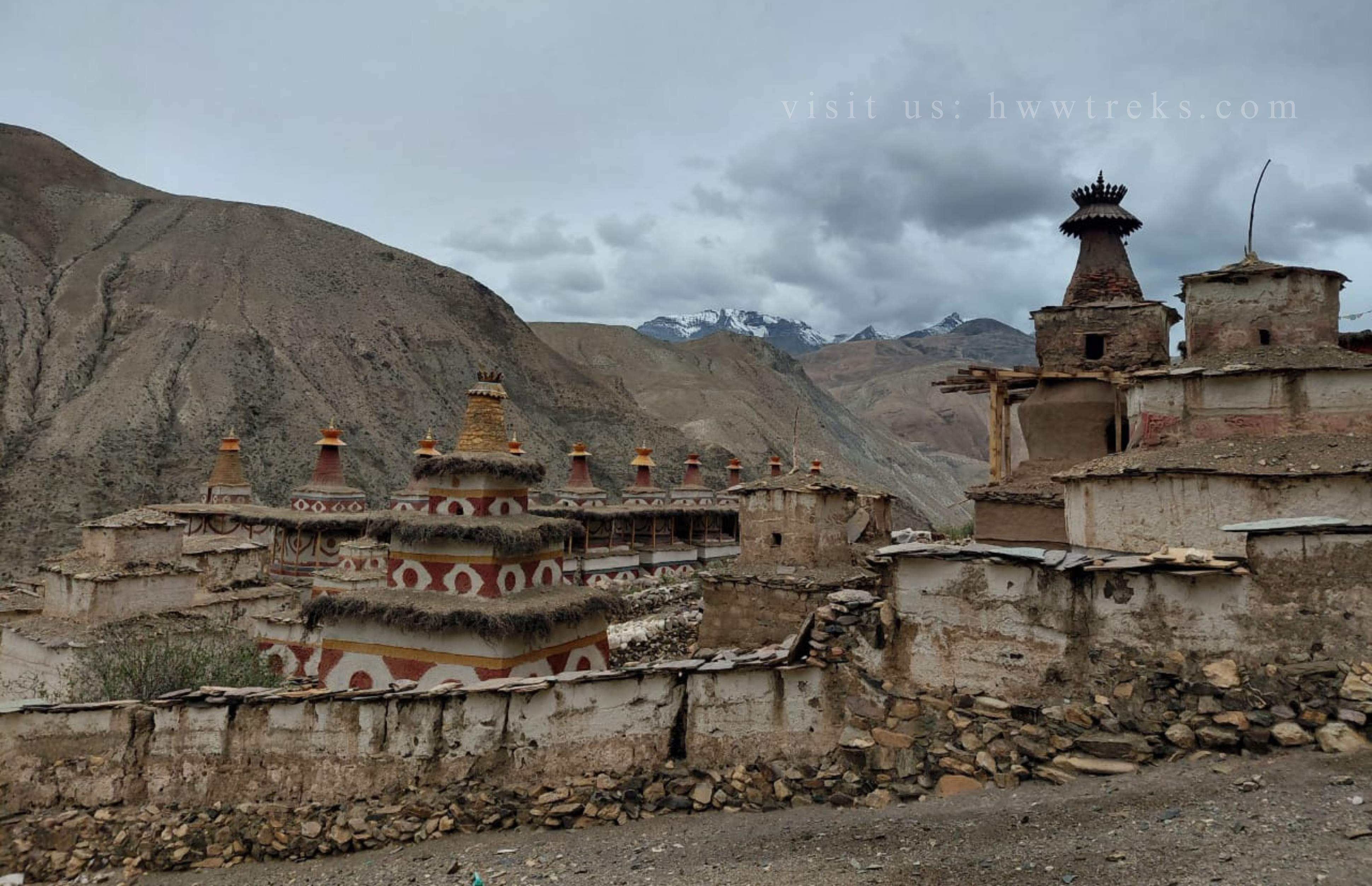
Nestled in the remote Nisal Village of Upper Dolpo, Yangtsher Gonpa is a lesser-known but deeply spiritual monastery known for preserving traditional Buddhist rituals. A defining feature of the site is the long rows of mani stones and chortens that line the way to the monastery, creating an atmosphere of sacred reverence. Surrounded by wild landscapes, it remains a quiet refuge for local monks and pilgrims.
Though simple in architecture, the monastery is rich in wall paintings and prayer symbols, embodying the peaceful essence of Himalayan Buddhism. Inside the Gonpa, visitors will find beautifully preserved statues and paintings of central Buddhist figures, including Guru Rinpoche (Padmasambhava), Shakyamuni Buddha, Chenrezig (Chyaraji), Dorje Chang, Green Tara, Mahakala, and the Eight Medicine Buddhas. The walls also honor important masters and protectors such as Atisha, Namkha Gyaltzen, Yamchenmo, Dolma Chewang, and Choekyal Palsangpo.
For those journeying into the wild beauty of Dolpo, Yangtsher Gonpa is not only a place of worship but also a powerful reminder of the region’s deep spiritual roots. Visiting this hidden site requires an Upper Dolpo trekking permit, and the journey typically begins from Saldang or Sibu, through high-altitude passes that offer dramatic views of the trans-Himalayan terrain.
Champa/ Jhampa Monastery
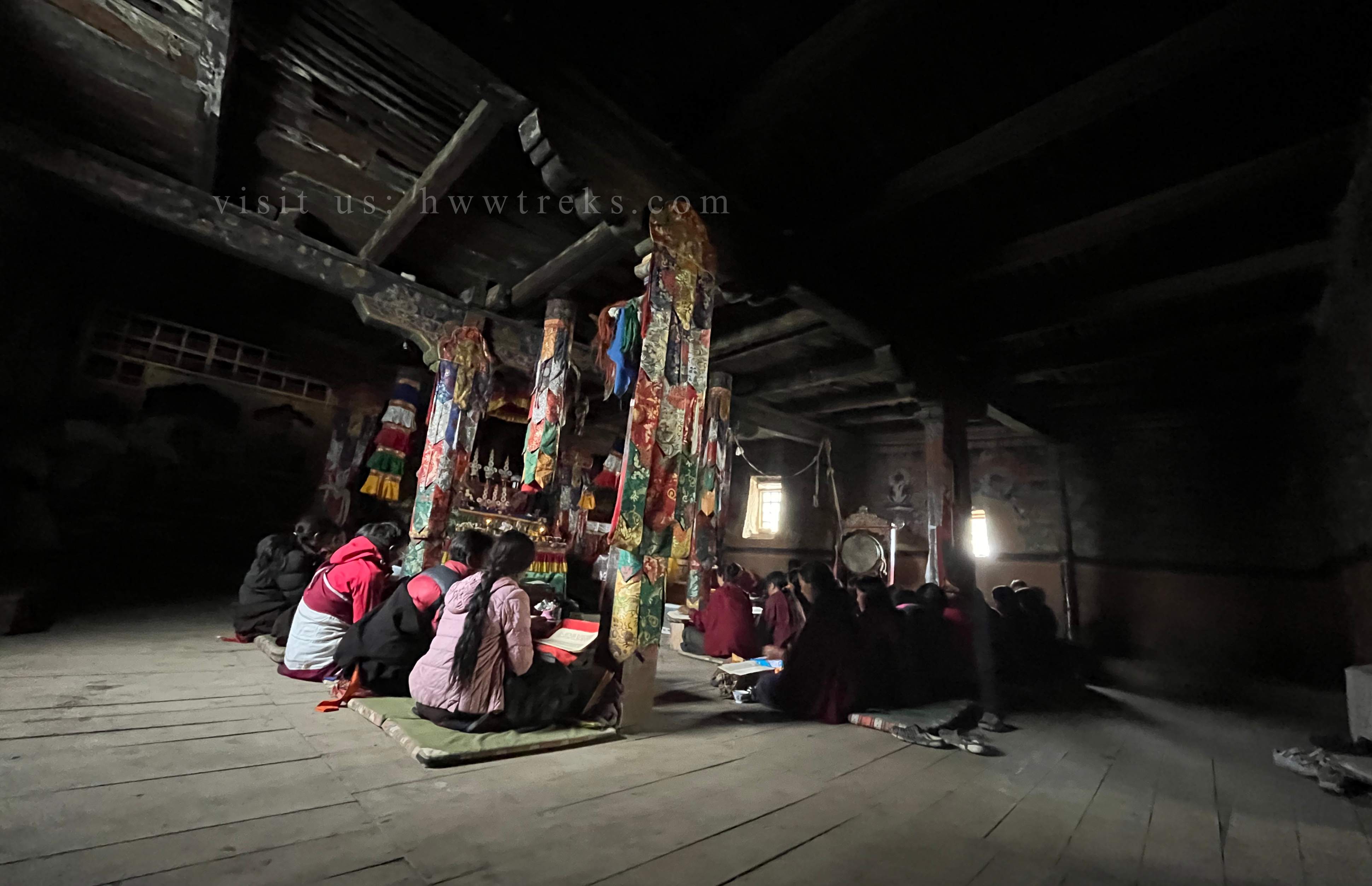
In the peaceful expanse of Tokyu village, nestled in the heart of Dolpo, stands the revered Champa (Jhampa) Monastery, a sacred site devoted to the Future Buddha, Maitreya. Though the original structure was lost to time, the current Nyingma-pa monastery traces its restoration back to the 15th century, when the King of Mustang rebuilt it and preserved its spiritual legacy.
Local legends add a mythical charm to the monastery’s story. It is said that the monastery was intended to be coated in white plaster, but no suitable materials could be found in the region. In an extraordinary turn, the master builder embarked on a journey riding a blue, hornless yak in search of what was needed, a tale that transformed this monastery into a pilgrimage destination for many across Upper Mustang and Dolpo.
Inside the monastery, the spiritual atmosphere is both majestic and humbling. There is a towering, one-story statue of Maitreya Buddha, surrounded by sacred figures such as Dipankara, Shakyamuni Buddha, the Thousand-Armed Avalokiteshvara (Chenresig), and a large image of Guru Rinpoche. The walls and shrine areas also feature depictions of seven fierce protector deities, Milarepa in the guardian chamber, and three striking white chortens just outside the complex.
In addition, Champa Monastery holds a wealth of ancient scriptures, sutras, and tantric texts, including a stupa dedicated to the Eight Medicine Buddhas, reinforcing its role as a spiritual stronghold of Dolpo’s Buddhist heritage.
Whether you are a pilgrim, a trekker, or a seeker of ancient wisdom, a visit to Champa Monastery offers a powerful connection to Dolpo’s spiritual depth and cultural richness.
Ribo Bhumpa Monastery- Cultural Center of Dho Tarap
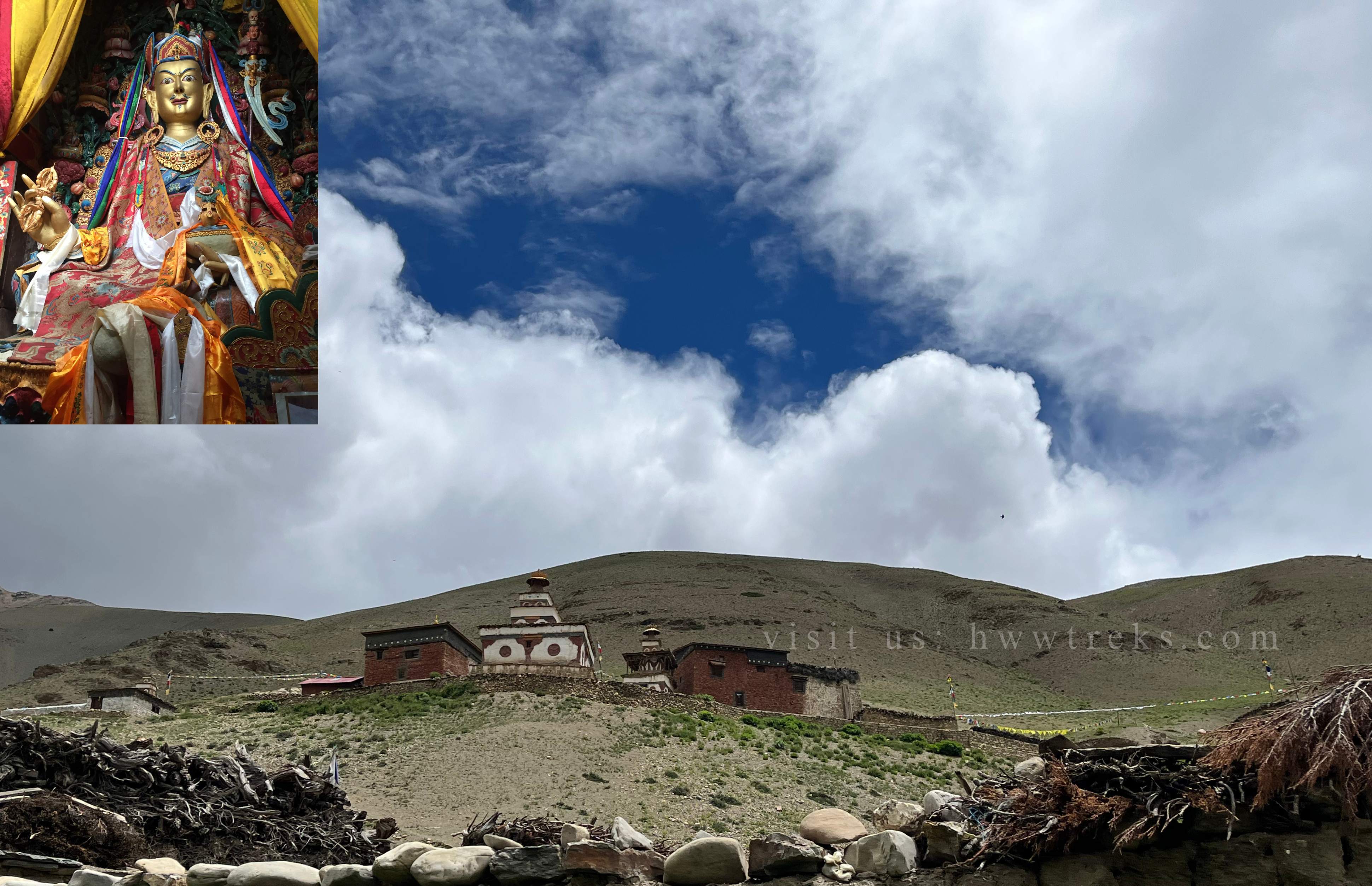
Ribo Bhumpa Monastery is a prominent Buddhist site in Dho Tarap, one of Dolpo's most scenic villages. The monastery is built in a sacred vase style, known as a Bumpa, one of the eight auspicious symbols in Buddhism, which represents abundance, purity, and spiritual blessings. This monastery was established over a millennium ago as part of the Nyingma tradition by Jigme Nyima Gyaltzen and Lama Tenzin Targye. Its structure is modeled after a renowned chorten at Samye Monastery in Lhasa, Tibet, a site of great historical and spiritual importance.
Legend has it that this monastery was built to ward off evil spirits that were said to wander the area. It is also believed that if the monastery were to be damaged, the Phoksundo Lake would burst, causing a flood in the nearby village.
Today, Ribo Bhumpa Monastery is known for its vibrant community of monks and beautifully painted interior walls. The monastery reflects a harmonious blend of Tibetan design and Himalayan culture. Murals depicting wrathful deities and protective guardians adorn the prayer halls, creating a powerful spiritual atmosphere. Located in Lower Dolpo, this area requires a standard permit ($20 per week), and the monastery is easily accessible during treks that pass through the Tarap Valley.
Sipchok Dedhen Phuntsokling Bon Monastery
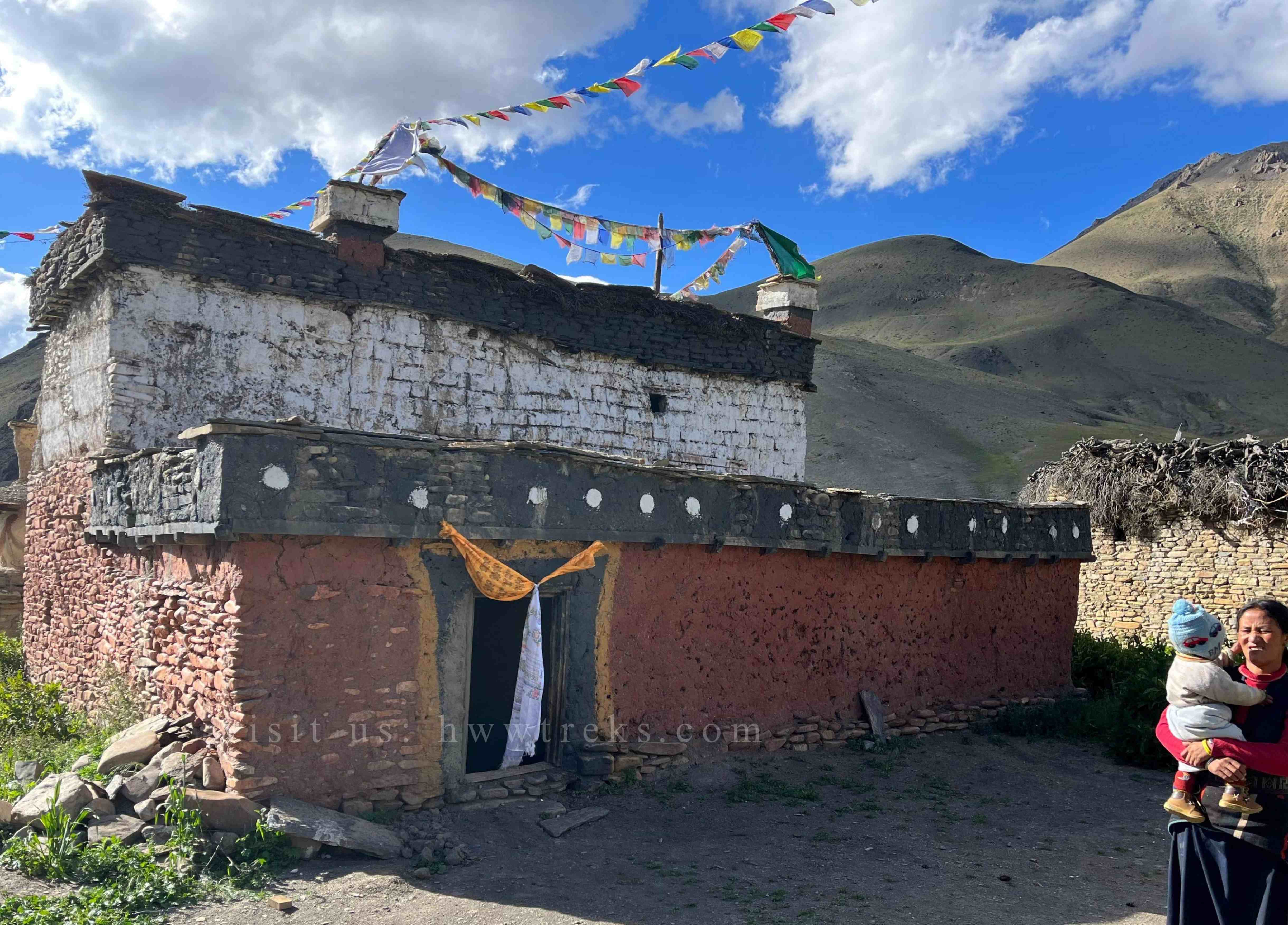 This active Bon monastery in the Sipchok area of Dho Tarap plays a vital role in preserving Bon culture. The word Shipchok means “sheltered place.” This must-see Bon Gonpa was founded 800 years ago by Triten Chime and was later rebuilt by Yundrung Gyaltzen about 500 years ago. Inside the monastery, there are many sacred images and scriptures, such as the 1000 Buddha-like images, “The Magnificent Pure Teaching,” and more. The walls at the entrance are decorated with mandalas and the four animal guardians. Outside, there are 15 chortens arranged in an arc across the meadows, with one isolated chorten on the side.
This active Bon monastery in the Sipchok area of Dho Tarap plays a vital role in preserving Bon culture. The word Shipchok means “sheltered place.” This must-see Bon Gonpa was founded 800 years ago by Triten Chime and was later rebuilt by Yundrung Gyaltzen about 500 years ago. Inside the monastery, there are many sacred images and scriptures, such as the 1000 Buddha-like images, “The Magnificent Pure Teaching,” and more. The walls at the entrance are decorated with mandalas and the four animal guardians. Outside, there are 15 chortens arranged in an arc across the meadows, with one isolated chorten on the side.
The monks of the Sipchok monastery conduct rituals for local villagers, and the prayer halls are filled with religious masks, drums, and hand-painted scriptures. The architecture reflects the classic Bon style, multi-tiered buildings, and red-gold decorative designs. Easily visited while exploring the Dho Tarap Valley with a Lower Dolpo permit, the monastery is a key highlight for those interested in Tibet’s indigenous faith.
Concluison
The monasteries of Dolpo are not just places of worship; they are living guardians of Himalayan heritage, wisdom, and resilience. From ancient Bon traditions to vibrant Buddhist art and architecture, each gonpa tells a timeless story. Whether you're drawn by spiritual curiosity or cultural exploration, visiting these sacred spaces offers a deeper connection to the land, its people, and the enduring spirit of Nepal’s hidden valleys. Let Dolpo's monasteries move your soul as much as its mountains and landscapes do.
For detailed information about the Dolpo Region, read our "Essential Guide and Top Tips for Trekking in the Dolpo Region."
Also, read our client's personal experience of trekking in the Dolpo Region.
